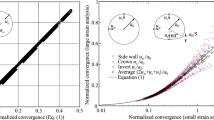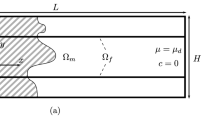Abstract
Fracture weakness prediction is an important task in fractured reservoir analysis. We propose a new method to use seismic amplitude differences between azimuths to estimate the normal and tangential fracture weaknesses under the assumption that the anisotropic perturbation of the reflection coefficient is mainly induced by fractures. We first derive an expression of the reflection coefficient in terms of the normal and tangential fracture weaknesses for the case of an interface separating two fractured media. Then we use the linear fitting method to get the relationship between the two fracture weaknesses, and change the variables to precondition the inversion problem. The Bayesian framework, under the hypothesis of a Cauchy distribution prior information and a Gaussian distribution likelihood function, is employed to construct the objective function, and an initial low-frequency constraint is introduced to the objective function to make the inversion more stable. The conjugate gradient algorithm is adopted to solve the inverse problem. Tests on both synthetic and real data demonstrate that the normal and tangential fracture weaknesses can be estimated reasonably in the case of seismic data containing a moderate noise, and our inversion approach appears to be a stable method for predicting the fracture weaknesses.

















Similar content being viewed by others
References
Bachrach, R., Sengupta, M., Salama, A., et al. (2009). Reconstruction of the layer anisotropic elastic parameter and high resolution fracture characterization from P-wave data: a case study using seismic inversion and Bayesian rock physics parameter estimation. Geophysical Prospecting, 57, 253–262.
Bakulin, A., Grechka, V., & Tsvankin, I. (2000). Estimation of fracture parameters from reflection seismic data-Part I: HTI model due to a single fracture set. Geophysics, 65, 1788–1802.
Buland, A., & Omre, H. (2003). Bayesian linearized AVO inversion. Geophysics, 68, 185–198.
Chen, H. Z., Yin, X. Y., Qu, S. L., et al. (2014). AVAZ inversion for fracture weakness parameters based on the rock physics model. Journal of Geophysics and Engineering, 11, 065007.
Downton, J. (2005). Seismic parameter estimation from AVO inversion: Ph.D. Thesis, University of Calgary.
Downton, J., & Roure, B. (2010). Azimuthal simultaneous elastic inversion for fracture detection, 80th Annual International Meeting (pp. 263–267). Expanded Abstracts: SEG.
Far, M. E., Hardage, B., & Wagner, D. (2014). Fracture parameter inversion for Marcellus Shale. Geophysics, 79, C55–C63.
Gray, D. (2004), Fracture detection using 3D azimuthal AVO, CSEG Recorder, 2004.
Gurevich, B. (2003). Elastic properties of saturated porous rocks with aligned fractures. Journal of Applied Geophysics, 54, 203–218.
Hampson, D., & Russell, B. (2005). Simultaneous inversion of pre-stack seismic data, CSEG National Convention, 1–4.
Hudson, J. A. (1980). Overall properties of a cracked solid. Mathematical Proceedings of the Cambridge Philosophical Society, 88, 371–384.
Hudson, J. A. (1981). Wave speeds and attenuation of elastic waves in material containing cracks. Geophysical Journal of the Royal Astronomical Society, 64, 133–150.
Mallick, S., Craft, K. L., Meister, L. J., et al. (1998). Determination of the principal directions of azimuthal anisotropy from P-wave seismic data. Geophysics, 63, 692–706.
Pšenčik, I., & Martins, J. L. (2001). Properties of weak contrast PP reflection/transmission coefficients for weakly anisotropic elastic media. Studia Geophysica et Geodaetica, 45, 176–199.
Pšenčik, I., & Vavryčuk, V. (1998). Weak contrast PP- wave displacement R/T coefficients in weakly anisotropic elastic media. Pure and Applied Geophysics, 151, 699–718.
Rüger, A. (1997). P-wave reflection coefficients for transversely isotropic models with vertical and horizontal axis of symmetry. Geophysics, 62, 713–722.
Rüger, A. (1998). Variation of P-wave reflectivity with offset and azimuth in anisotropic media. Geophysics, 63, 935–947.
Sacchi, M. D., & Ulrych, T. J. (1995). High-resolution velocity gathers and offset space reconstruction. Geophysics, 60, 1169–1177.
Schoenberg, M. (1980). Elastic wave behavior across linear slip interfaces. Journal of Acoustical Society of America, 68, 1516–1521.
Schoenberg, M., & Protazio, J. (1992). ‘Zoeppritz’ rationalized and generalized to anisotropy. Seismic Exploration, 1, 125–144.
Schoenberg, M., & Sayers, C. M. (1995). Seismic anisotropy of fractured rock. Geophysics, 60, 204–211.
Shaw, R. K., & Sen, M. K. (2004). Born integral, stationary phase and linearized reflection coefficients in weak anisotropic media. Geophysical Journal International, 158, 225–238.
Shaw, R. K., & Sen, M. K. (2006). Use of AVOA data to estimate fluid indicator in a vertically fractured medium. Geophysics, 71, C15–C24.
Shewchuck, J. (1994). An introduction to the conjugate gradient method without the agonizing pain, School of Computer Science. Carnegie Mellon University. Pittsburg. (available at http://www-2.cs.cmu.edu/~jrs/jrspapers.html).
Tarantola, A. (2005). Inverse problem theory and methods for model parameter estimation, Society for Industrial and Applied Mathematics Philadelphia.
Thomsen, L. (1986). Weak elastic anisotropy. Geophysics, 51, 1954–1966.
Xu, S. Y. (2009). Integrated anisotropic rock physics model, US patent.
Zong, Z., Yin, X., & Wu, G. (2012). AVO inversion and poroelasticity with P- and S-wave moduli. Geophysics, 77, N29–N36.
Acknowledgments
We acknowledge the sponsorship of the National High-tech R&D Program of China (863 Program, 2013AA064201) for funding this research. We are grateful for the support from the SINOPEC Key Lab of Multi-Component Seismic Technology. We also thank the anonymous reviewers for their constructive suggestions. We are grateful for the help from David Henley and Kristopher Innanen.
Author information
Authors and Affiliations
Corresponding author
Appendix A: The Derivation of PP-Wave Reflection Coefficient
Appendix A: The Derivation of PP-Wave Reflection Coefficient
The relationships among m, n, i, j, k and l in Eq. (5) are given by Shaw and Sen (2006)
where \(\delta_{{\text{ij}}}\) and \(\delta_{{\text{kl}}}\) are Kronecker delta.
For the case of the P-wave incidence and P-wave reflection, the polarization and slowness vectors are given by
The expression of η is given by
The calculation of the scattering function is given by
Substituting Eq. (31) into Eq. (4) yields
Rights and permissions
About this article
Cite this article
Chen, H., Zhang, G., Ji, Y. et al. Azimuthal Seismic Amplitude Difference Inversion for Fracture Weakness. Pure Appl. Geophys. 174, 279–291 (2017). https://doi.org/10.1007/s00024-016-1377-x
Received:
Revised:
Accepted:
Published:
Issue Date:
DOI: https://doi.org/10.1007/s00024-016-1377-x




